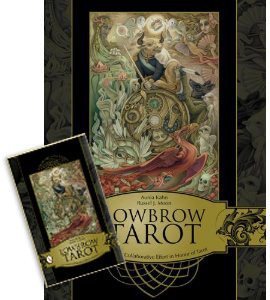For almost 80 years, Kirkus Reviews has served as the industry bible for bookstore buyers, librarians, and ordinary readers alike. Now Popdose joins the Kirkus Book Bloggers Network to explore the best — and sometimes the worst — in pop-culture and celebrity books.
This week, let’s tell the future — the future of art…

I own more than three decks of Tarot cards — which I suppose makes me a collector — and my library contains at least one acknowledged classic book on the topic (Rachel Pollack’s Seventy-Eight Degrees of Wisdom), which I suppose makes me an aficionado. I don’t use em for divination, mind. I’m a mystic, sure, in the sense of awareness of the presence of the numinous and all that, but in a loosey-goosey Van Morrison kind of way — no guru, no method, no teacher.
So I’m not sold on the cards as a system of knowledge, no. But as a medium for artistic expression, it’s marvelous. The Major Arcana are for visual artists what the standards are for jazz players — a sturdy framework begging for the artist’s personal stamp, a readymade schema of icons and archetypes to tweak, to play with, to explore and interpret.
The Lowbrow Tarot (Schiffer Press, edited by Aunia Kahn and Russell J. Moon) isn’t a working deck, of course. It’s a stunning, 144-page art book, released (appropriately enough) on Halloween, documenting a 2010 Los Angeles gallery show that brought together 23 top pop-surrealist artists, each interpreting one of the Major Arcana — those highly symbolic trump cards of the Tarot deck; the Fool, the Lovers, Death, Judgment, and so on. In this collection, those themed works (mostly paintings, but including sculpture, charcoal drawings, and collage) are presented along with a representative sampling of each artist’s output, making The Lowbrow Tarot a sort of primer on the scene.
The lowbrow aesthetic — too ubiquitous now to be properly called a movement, and too wide-ranging to be properly called a school, popularized by painter/publisher Robert Williams and his journal Juxtapoz — emphasizes slick draftsmanship and a painterly figurative approach. DalÁ and Magritte are the spiritual godfathers, but lowbrow bubbles with the influence and energy of mid-century junk culture: tattoo flash, comics and trading cards, commercial art, pulps and men’s magazines and cheesecake, all teeming with idiosyncratic symbols and obsessive detail. It’s a natural fit for the fraught and coded images of the Tarot.
In fact, it may be a little too cozy. Some of the pictures lose their impact when seen in the context of the artist’s body of work. Laurie Lipton, for instance, interprets the Death card in charcoal and pencil as a Grim Reaper figure on a rearing skeleton horse. It’s a striking image on its own, all ghostly silver and gray — but skeleton imagery is so ubiquitous in Lipton’s other work that her take on Death looks, on reconsideration, a little too obvious, even lazy. She’s certainly not stretching significantly out of her artistic comfort zone.
In the same way, Brian Viveros’s interpretation of Strength as a young woman in a military helmet, swaddled in bandages, cigar in her crimson mouth, is initially arresting — until one sees the rest of his images; they all feature head-and-shoulders shots of young women, all smoking, all wearing some kind of headgear. Fourteen of Viveros’s paintings are reproduced in total, and they are, without exception, minute variations on a single theme — the same smudged lipstick and running mascara, the same bandages, the same red rose. The line between motif and fetish grows blurry, and thematic unity starts to look like a one-trick pony.
But if many of the pictures use elements that are by now overly familiar — steampunk gas masks, burlesque, kitsch religious iconography and Mexican folk-art stylings — there are some new and wondrous images here…
Read the rest of this article at Kirkus Reviews!





Comments